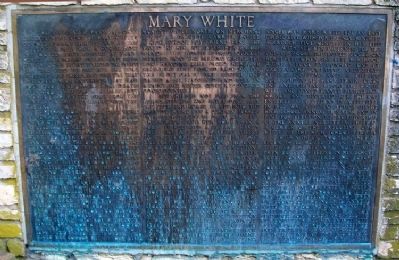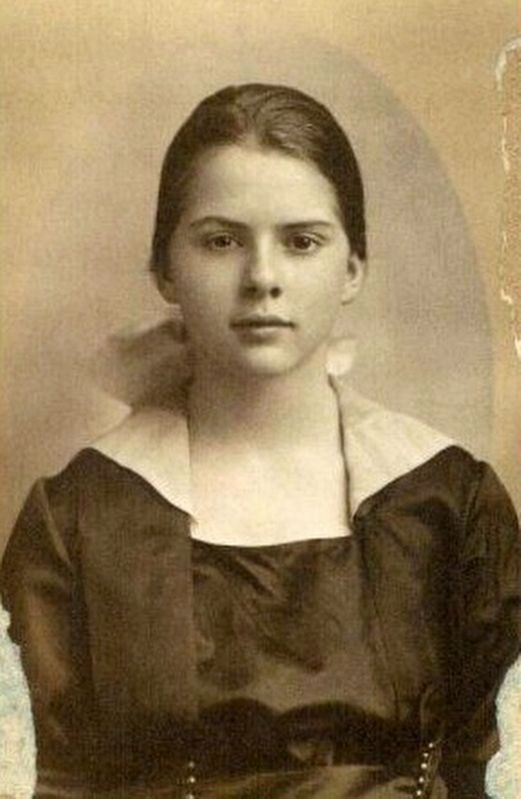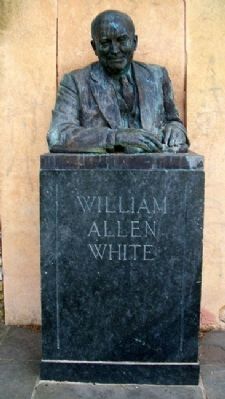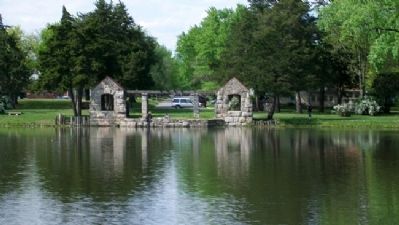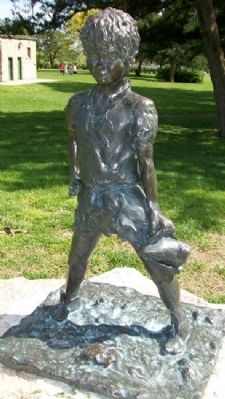Emporia in Lyon County, Kansas — The American Midwest (Upper Plains)
Mary White
The Associated Press reports carrying the news of Mary White's death declared that it came as the result of a fall from a horse. How she would have hooted at that! Horses have fallen on her and with her - "I'm always trying to hold 'em in my lap," she used to say. But she was proud of few things, and one was that she could ride anything that had four legs and hair. Her death resulted not from a fall, but from a blow on the head from the limb of a tree overhanging the parking.
She had come from a day's work at school, topped off by a hard grind with copy on the High School Annual. She climbed into her khakis, chattering to her mother about her work, and hurried to get her horse and be out on the dirt roads for the country air and the radiant green fields of spring. As she rode through the town on an easy gallop she kept waving at passers-by. For a decade the little figure with the long pig-tail and the red hair ribbon has been familiar on the streets of Emporia, and she got in the way of speaking to those who nodded at her. She passed the Kerrs, walking their horse in front of the Normal Library, and waved at them, passed another friend a few hundred feet further on and waved at her. The horse was walking as she turned into North Merchant Street. She took off her cowboy hat and the horse swung into a lope. She passed the Tripletts and waved her cowboy hat at them, still moving gaily north on Merchant Street. A Gazette carrier passed - a High School boy friend - and she waved at him, but with her bridle hand; the horse veered quickly, plunged into the parking where the low-hanging limb faced her, and while she still looked back waving, the blow came. She slipped off, dazed a bit, staggered and fell in a faint. She never quite recovered consciousness.
But she did not fall from the horse, neither was she riding fast. She used the horse to get into the open to work off a certain surplus energy that welled up in her. But the riding gave her more than a body. It released a gay and hardy soul. She was the happiest thing in the world, because she was enlarging her horizons. She came to know all sorts and conditions of men; Charley O'Brien, the traffic cop, was one of her best friends. W. L. Holtz, the Latin teacher, was another. Tom O'Connor, farmer-politican and Rev. J. H. J. Rice, preacher and police judge, and Frank Beach, music master, were her special friends; and all the girls, black and white, above the track and below the track, in Pepville and Stringtown, were among her acquaintances. She brought home riotous stories of her adventures. She loved to rollick; persiflage was her natural expression at home. Her humor was a continual bubble of joy. She seemed to think in the hyperbole and metaphor. She was mischievous without malice, as full of faults as an old shoe. No angel was Mary White, but an easy girl to live with, for she never nursed a grouch five minutes in her life.
With all her eagerness for the out-of-doors, she loved books. On her table when she left her room were a book by Conrad, one by Galsworthy, "Creative Chemistry" by E. E. Slossen [sic - Slosson], and a Kipling book. She read Mark Twain, Dickens and Kipling before she was 10. Wells and Arnold Bennett particularly amused and diverted her. She was entered as a student in Wellesley in 1922: was assistant editor of the High School Annual this year, and in line for election to the editorship of the Annual next year. She was a member of the executive committee of the High School Y.W.C.A.
Within the last two years she had begun to be moved by an ambition to draw. She began as most children do by scribbling in her school books, funny pictures. She bought cartoon magazines and took a course -- rather casually, naturally for she was, after all, a child with no strong purposes -- and this year she tasted the first fruits of success by having her pictures accepted by the High School Annual. But the thrill of delight she got when Mr. Ecord, of the Normal Annual asked her to do the cartooning for that book this spring, was too beautiful for words. She fell to her work with all her enthusiastic heart. Her drawings were accepted and her pride, always repressed by a lively sense of the ridiculous, was a really gorgeous thing to see. No successful artist ever drank a deeper draught of satisfaction than she took from the little fame her work was getting among her school fellows. In her glory, she almost forgot her horse -- but never her car.
For she used the car as a jitney bus. It was her social life. She never had a "party" in all her nearly seventeen years -- wouldn't have one; but she never drove a block in the car in her life that she didn't begin to fill the car with pick-ups. Everybody rode with Mary White -- white and black, old and young, rich and poor, men and women. She liked nothing better than to fill the car full of longlegged High School boys and an occasional girl, and parade the town. She never had a "date," nor went to a dance, except once with her brother, Bill. Boys didn't interest her - yet. But young people - great spring-breaking, varnish-cracking, fender-bending, door-sagging carloads of "kids" -- gave her great pleasure. Her zests were keen. But the most fun she ever had in her life was acting as chairman of the committee that got up the big turkey dinner for the poor folks at the county home; scores of pies, gallons of slaw, jam, cakes, preserves, oranges and a wilderness of turkey were loaded in the car and taken to the county home. And, being of a practical turn of mind she risked her own Christmas dinner by staying to see that the poor folks actually got it all. Not that she was a cynic, she just disliked to tempt folks. While there she found a blind colored uncle, very old, who could do nothing but make rag rugs and she rustled up from her school friends rags enough to keep him busy for a season. The last engagement she tried to make was to take the guests at the county home out for a car ride. And the last endeavor of her life was to try to get a rest room for colored girls in the High School. She found one girl reading in the toilet, because there was no better place for a colored girl to loaf. It inflamed her sense of justice and she became a nagging harpy to those who she thought could remedy the evil. The poor, she had always with her and was glad of it. She hungered and thirsted for righteousness, and was the most impious creature in the world. She joined the Congregational Church without consulting her parents, not particularly for her soul's good. She never had a thrill of piety in her life, but even as a little child she felt the church was an agency for helping people to more of life's abundance and she wanted to help.
She never wanted help for herself, clothes meant little to her. It was a fight to get a new rig on her; but eventually a harder fight to get it off. She never wore a jewel and had
no ring but her High School class ring, and never asked for anything but a wrist watch. She refused to have her hair up, though she was nearly 17. "Mother" she protested, "you don't know how much I get by with in my braided pigtails that I could not with my hair up." Above every other passion of her life was her passion not to grow up, to be a child. The tom-boy in her, which was big, seemed to loath to be put away forever in skirts. She was a Peter Pan, who refused to grow up.
Her funeral yesterday at the Congregational Church was as she would have wished it; no singing, no flowers, save the big bunch of red roses from her brother Bill's Harvard classmen. Heavens how proud that would have made her. And the red roses from the Gazette force in vases at her head and feet. A short prayer, Paul's beautiful essay on "Love" from the Thirteenth Chapter of First Corinthians, some remarks about her democratic spirit by her friend John H. J. Rice, pastor and police judge, which she would have deprecated if she could, a prayer sent down for her by her friend, Carl Nau, and, opening the service, the slow, poignant movement from Beethoven's Moonlight Sonata which she loved, and in closing a cutting from the joyously melancholy first movement of Tschaikowski's Pathetic Symphony which she like to hear in certain moods on the phonograph, then the Lord's Prayer by her friends in the High School.
That was all.
For her pallbearers only her friends were chosen: her Latin teacher, W. L. Holtz; her high school principal, Rice Brown; her doctor, Frank Foncannon; her friend, W. W. Finney; her pal at the Gazette office, Walter Hughes; and her brother Bill. It would have made her smile to know that her friend, Charley O'Brien, the traffic cop, had been transferred from Sixth and Commercial to the corner near the church to direct her friends who came to bid her goodbye.
A rift in the coulds in a gray day threw a shaft of sunlight upon her coffin as her nervous, energetic, little body sank to its last sleep. But the soul of her, the glowing, gorgeous, fervent soul of her, surely was flaming in eager joy upon some other dawn.
W. A. W.
Topics. This historical marker is listed in these topic lists: Arts, Letters, Music • Communications • Women. A significant historical year for this entry is 1922.
Location. 38° 23.639′ N, 96° 11.278′ W. Marker is in Emporia, Kansas, in Lyon County. Memorial is along the lake shore in Peter Pan Park, about 400 feet WSW of the intersection of Kansas Avenue and Neosho Street. Touch for map. Marker is in this post office area: Emporia KS 66801, United States of America. Touch for directions.
Other nearby markers. At least 8 other markers are within walking distance of this marker. World War II Memorial at St. Catherine's Church (approx. 0.3 miles away); Grant Frederick Timmerman (approx. 0.6 miles away); Purple Heart Memorial (approx. 0.6 miles away); Emporia's Liberty Bell (approx. 0.6 miles away); Vietnam Memorial (approx. 0.6 miles away); Alvin J. King (approx. 0.6 miles away); Lebanon, Grenada, and Panama Veterans Memorial (approx. 0.6 miles away); Emporia High School World War II Memorial (approx. 0.6 miles away). Touch for a list and map of all markers in Emporia.
Regarding Mary White. Mary White was born in 1904 and died in 1921.She was 16 years old. Her father, the author of this eulogy, was the owner-editor of the Emporia Gazette. His name was William Allen White (1868–1944).
Also see . . .
1. Mary White obituary. Kansapedia website entry:
William Allen White's full Emporia Gazette remembrance, as printed on the marker (Submitted on November 28, 2011, by William Fischer, Jr. of Scranton, Pennsylvania.)
2. A Prairie Peter Pan: The Story of Mary White. 2010 book by Beverly Olson Buller on Amazon.com. Using William Allen White’s essay as a framework, the author recounts the life of Mary White. (Submitted on December 1, 2011.)
Credits. This page was last revised on November 2, 2023. It was originally submitted on November 27, 2011, by William Fischer, Jr. of Scranton, Pennsylvania. This page has been viewed 1,857 times since then and 27 times this year. It was the Marker of the Week December 18, 2011. Photos: 1. submitted on November 28, 2011, by William Fischer, Jr. of Scranton, Pennsylvania. 2. submitted on January 17, 2022, by Larry Gertner of New York, New York. 3, 4, 5, 6. submitted on November 28, 2011, by William Fischer, Jr. of Scranton, Pennsylvania.
Editor’s want-list for this marker. Full photo of second panel • Can you help?
